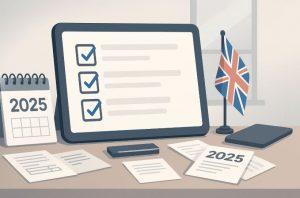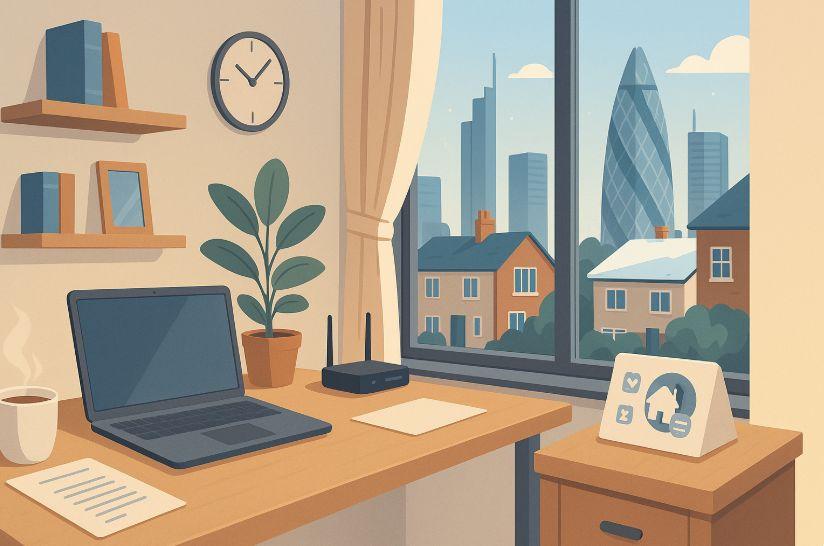As remote and hybrid working models become the new norm, many UK workers are looking for ways to reduce their tax bills. One key financial benefit available to qualifying individuals is the HMRC working from home allowance.
In 2025, HMRC has refined its policies and guidelines to reflect current work trends, providing clarity on who can claim, how much they can claim, and what expenses are eligible. This guide explains everything London-based professionals need to know about claiming this tax relief accurately and effectively.
What Is the HMRC Working From Home Allowance?

The HMRC working from home allowance is a tax relief that allows eligible employees and self-employed individuals to reclaim some of the additional household costs incurred due to working from home. Initially introduced to assist workers during the COVID-19 pandemic, the scheme has since been adjusted to reflect the post-pandemic remote work landscape.
Understanding the Concept
Tax relief is granted based on either a flat rate determined by HMRC or the actual costs incurred. The purpose is to offset the increase in bills such as electricity, heating, and internet caused by consistent home-based work.
HMRC’s Role
Her Majesty’s Revenue and Customs (HMRC) manages the claims process, eligibility criteria, and payment of rebates. The allowance is not a separate grant but a reduction in the amount of income tax you need to pay, increasing your take-home pay.
Who Is Eligible for the Work From Home Tax Relief in 2025?
Eligibility in 2025 is more specific than in previous years. Not everyone who occasionally works from home can claim the tax relief.
Eligibility Criteria for Employees
- Must have been required to work from home by their employer
- Cannot have received reimbursement from their employer for the additional costs
- Must be using their own utilities and home space to perform work duties
- Part-time and hybrid workers may qualify only if home working is mandatory on specified days
Self-Employed Eligibility
Self-employed individuals can claim a different type of expense relief, where they deduct business-related home costs through their Self Assessment tax return. The criteria are broader but must be backed with detailed records.
How Much Can You Claim for Working From Home in 2025?
HMRC allows individuals to choose between two options: flat rate deduction or actual costs. Here’s a detailed comparison:
Flat Rate vs Actual Cost Method
| Claim Type | Amount | Details |
| Flat Rate | £6 per week (£312 annually) | No receipts required. This is the easiest method for most employees. |
| Actual Costs | Variable (based on usage) | Requires proof of expenses like bills, and calculation of work-related use. |
Choosing the Best Option
The flat rate is ideal for employees without detailed records, whereas actual costs might result in higher claims if you work from home full-time and have significant utility expenses.
What Expenses Can Be Included in a Home Office Tax Claim?

Only certain types of expenses are allowable under HMRC guidelines. These typically relate to incremental costs that arise as a direct result of working from home.
Utilities and Services
This includes electricity, heating, and water used during work hours. If you use your internet connection for work, a proportionate claim is allowed.
Phone and Internet
Additional phone call costs and higher broadband usage directly linked to work can be partially reclaimed.
Equipment and Furniture
While desks and chairs are generally not claimable unless provided by the employer, repairs to work-related items or small office supplies can sometimes be included in the actual costs method.
What You Cannot Claim?
You cannot claim rent or mortgage payments, council tax, or food and drink expenses. These are considered fixed personal costs not directly related to work.
How Can Employees Claim the HMRC Working From Home Allowance?
The process for employed workers who are not self-assessed is straightforward but must be followed carefully.
Step-by-Step Claim Process
Using the P87 Form
The P87 form is the most commonly used method for employees claiming flat-rate tax relief. It can be submitted:
- Online via the HMRC Government Gateway
- By post using the downloadable P87 PDF
You’ll need your employer’s PAYE reference number, and details of your job role and working arrangements.
Through Self Assessment
If you already file a self-assessment tax return, you can include the home working expenses in the employment expenses section of the form.
Can Self-Employed Workers Claim Home Office Expenses Differently?
Yes, self-employed professionals have access to a broader range of deductions and a different method of calculation.
Simplified Expenses Method
Self-employed individuals can use HMRC’s simplified expenses system, which provides a flat monthly deduction based on the number of hours worked at home.
| Hours Worked at Home (Monthly) | Monthly Flat Rate |
| 25 to 50 | £10 |
| 51 to 100 | £18 |
| 101 or more | £26 |
Detailed Expense Method
For those with higher costs or a dedicated home office space, calculating actual costs based on square footage and work hours may result in a larger deduction.
What Has Changed in the 2025 HMRC Guidelines?

The 2025 updates reflect an effort by HMRC to adapt to the hybrid work model.
Stricter Eligibility
Claims are now only accepted if the employee is mandated to work from home by their employer. Voluntary or flexible home working arrangements are no longer eligible.
Updated Forms and Processes
Online submissions have been streamlined, and HMRC has updated its digital services for quicker claim tracking and feedback.
Flat Rate Remains the Same
Despite inflation, the flat rate remains at £6 per week, unchanged since 2020.
How Long Does It Take to Receive the Tax Refund?
Once your claim is submitted, the refund timeline depends on the method used and HMRC’s processing load.
Average Processing Time
- Online P87 Form: Usually processed within 6 weeks
- Self-Assessment Return: Processed along with the annual tax return by 31 January 2026
Refunds are typically paid directly into your bank account, or reflected as a PAYE tax code adjustment in the next salary cycle.
Are There Any Common Mistakes When Claiming Home Working Tax Relief?
Mistakes can result in delays or outright rejections. In 2024, HMRC rejected thousands of claims due to errors.
Submitting Without Being Required to Work from Home
Claimants must prove their home working was mandated, not optional.
Claiming Non-Eligible Costs
Including rent, food, or commuting costs leads to automatic rejections.
Using Incorrect Forms
Employees sometimes file using the self-employed section or vice versa, which causes delays.
What Are the Benefits of Claiming This Allowance?

The primary benefit is financial relief. Over the course of a year, the allowance helps offset rising energy bills and internet costs.
Simpler Tax Planning
Claiming through PAYE or self-assessment can streamline your financial tracking and reduce taxable income.
Reduced Financial Stress
As living costs rise in the UK, any legitimate tax relief can ease pressure on working professionals and families.
How Often Can You Claim the HMRC Working From Home Allowance?
Understanding the frequency of claiming the HMRC working from home allowance is essential for employees and self-employed individuals who wish to remain compliant and maximise their tax relief.
Annual vs One-Time Claim
For most employed individuals using the P87 form, the claim is submitted once per tax year. You don’t need to submit a monthly or quarterly request HMRC calculates your annual entitlement based on your claim for the relevant tax year (e.g., April 6, 2024 – April 5, 2025).
Claiming Multiple Years
If you missed claiming in previous years when you were eligible, HMRC allows backdating claims for up to four tax years. This means that in 2025, you could claim for 2021/22, 2022/23, 2023/24, and 2024/25 provided you met the eligibility criteria during those periods.
For Self-Assessment Taxpayers
Those filing via Self Assessment claim their home working expenses annually within their tax return. You must include the relevant details each year; it does not carry forward automatically.
Even if you claim the flat rate of £6 per week, you must reapply or include it in your tax return every year. HMRC does not automatically continue claims unless specifically indicated on your PAYE tax code.
What Records Should You Keep When Claiming Work From Home Tax Relief?
Whether you’re claiming a flat rate or actual expenses, record-keeping is vital. HMRC may not request documents at the point of submission, but they can ask for them during a compliance check or audit.
Flat Rate Claims
If you’re claiming the £6/week flat rate, the documentation requirement is minimal. However, you should still keep:
Proof of Home Working
- A letter or contract from your employer showing that you were required to work from home
- Copies of work emails or shift patterns that demonstrate remote working obligations
Actual Expenses Claims
If you opt to claim for actual expenses, you’ll need more detailed records:
Utility Bills and Internet Statements
You should keep monthly bills that show increased usage due to home working. For shared bills, calculate the proportion of your home used for work and the number of work hours.
Work Diary or Usage Logs
Maintain a record of your working hours and the percentage of household use related to work activities. This helps justify your percentage-based expense claims.
Record Retention Period
HMRC advises keeping tax-related documents for at least 22 months after the end of the tax year (for employees) or 5 years after the submission deadline for self-assessed individuals.
Conclusion
Claiming the HMRC working from home allowance in 2025 requires understanding the updated eligibility rules, selecting the right claim method, and keeping proper records.
Whether you’re an employee using a P87 form or a self-employed individual filing through self-assessment, there’s an opportunity to reduce your tax liability legally and efficiently.
Staying informed and proactive ensures you don’t leave money on the table in the evolving landscape of remote work.
FAQs
How do I know if I qualify for the HMRC home office tax relief?
If your employer requires you to work from home and you incur additional costs, you likely qualify under HMRC’s 2025 rules.
Can I backdate my working from home claim?
Yes, claims can typically be backdated up to four tax years, provided you were eligible during those periods.
Does hybrid working still qualify for tax relief?
Only if you are mandated to work from home for at least part of your working week. Voluntary remote days do not qualify.
What if my employer reimburses my expenses?
If your employer covers your expenses, you cannot also claim tax relief for those same costs from HMRC.
Can directors of limited companies claim home office expenses?
Yes, but they must do so through company expense deductions, not via P87. The method depends on how the company is structured.
Is it better to claim the flat rate or actual costs?
The flat rate is simpler, but if you work from home full-time and have higher costs, actual costs may yield a better return.
Do students working part-time from home qualify?
Only if they are employed and PAYE registered, with mandatory home working requirements.









Leave feedback about this